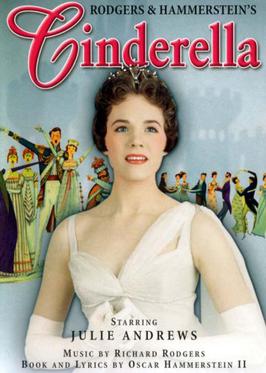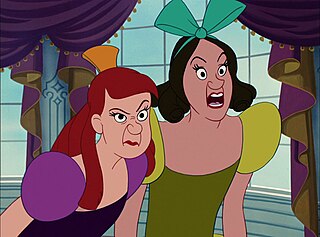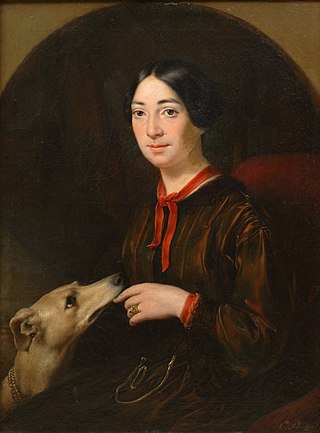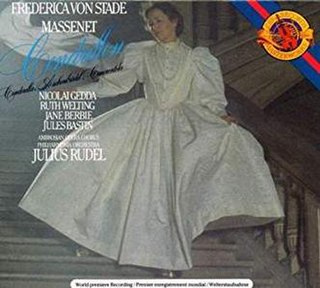"Cinderella", or "The Little Glass Slipper", is a folk tale with thousands of variants that are told throughout the world. The protagonist is a young girl living in forsaken circumstances that are suddenly changed to remarkable fortune, with her ascension to the throne via marriage. The story of Rhodopis, recounted by the Greek geographer Strabo sometime between 7 BCE and 23 CE, about a Greek slave girl who marries the king of Egypt, is usually considered to be the earliest known variant of the Cinderella story.

Pauline Viardot was a French dramatic mezzo-soprano, composer and pedagogue of Spanish descent. Born Michelle Ferdinande Pauline García, she came from a musical family and took up music at a young age. She began performing as a teenager and had a long and illustrious career as a star performer.
Cinderella Op. 87, is a ballet composed by Sergei Prokofiev to a scenario by Nikolai Volkov. It is one of his most popular and melodious compositions, and has inspired a great many choreographers since its inception. The piece was composed between 1940 and 1944. Part way through writing it Prokofiev broke off to write his opera War and Peace. The premiere of Cinderella was conducted by Yuri Fayer on 21 November, 1945, at the Bolshoi Theatre, with choreography by Rostislav Zakharov and Galina Ulanova in the title role. Cinderella is notable for its jubilant music, lush scenery, and for the comic double-roles of the stepmother and the two stepsisters, more mad than bad in this treatment.

La Cenerentola, ossia La bontà in trionfo is an operatic dramma giocoso in two acts by Gioachino Rossini. The libretto was written by Jacopo Ferretti, based on the libretti written by Charles-Guillaume Étienne for the opera Cendrillon with music by Nicolas Isouard and by Francesco Fiorini for Agatina, o la virtù premiata with music by Stefano Pavesi. All these operas are versions of the fairy tale Cendrillon by Charles Perrault. Rossini's opera was first performed in Rome's Teatro Valle on 25 January 1817.

Rodgers and Hammerstein's Cinderella is a musical written for television, but later played on stage, with music by Richard Rodgers and a book and lyrics by Oscar Hammerstein II. It is based upon the fairy tale Cinderella, particularly the French version Cendrillon, ou la petite pantoufle de verre, by Charles Perrault. The story concerns a young woman forced into a life of servitude by her cruel stepmother and self-centered stepsisters, who dreams of a better life. With the help of her fairy godmother, Cinderella is transformed into a princess and finds her prince.
Cinderella is a classic fairy tale.

The ugly stepsisters are characters in the fairy tale and pantomime, Cinderella. They are the daughters of Cinderella's wicked stepmother, who treat her poorly. The "ugly stepsisters" have been in variations of the story from as early as researchers have been able to determine.

Cendrillon (Cinderella) is an opera—described as a "fairy tale"—in four acts by Jules Massenet to a French libretto by Henri Caïn based on Perrault's 1698 version of the Cinderella fairy tale.
Amanda Forsythe is an American light lyric soprano who is particularly admired for her interpretations of baroque music and the works of Rossini. Forsythe has received continued critical acclaim from many publications including Opera News, The New York Times, The Wall Street Journal and the Boston Globe.

Cinderella is a ballet-féerie in three acts, with the choreography of Enrico Cecchetti and Lev Ivanov supervised by Marius Petipa. Music is by Baron Boris Fitinhoff-Schell; the libretto is by Lidia Pashkova and Ivan Vsevolozhsky. It was first presented by the Imperial Ballet on 17 December [O.S. 5 December] 1893 at the Imperial Mariinsky Theatre in St. Petersburg, Russian Empire.
"Ye Xian" is a Chinese fairy tale that is similar to the European Cinderella story, the Malay-Indonesian Bawang Putih Bawang Merah tale, the Vietnamese Tấm Cám story, and stories from other ethnic groups including the Tibetans and the Zhuang. It is one of the oldest known variants of Cinderella, first published in the Tang dynasty compilation Miscellaneous Morsels from Youyang written around 850 by Duan Chengshi. Chinese compilations attest several versions from oral sources.

Sapho is an opera in three acts by Charles Gounod, premiered 16 April 1851 at Salle Le Peletier of the Paris Opera. The libretto was by Émile Augier after the life of the poet Sappho of Lesbos. The creation of the work was given an impetus by, and provided a central role for, the mezzo-soprano Pauline Viardot.

Cendrillon is a French opera in three acts by the Maltese-born composer Nicolas Isouard. It takes the form of an opéra comique with spoken dialogue between the musical numbers, although its authors designated it an opéra féerie. The libretto, by Charles-Guillaume Étienne, is based on Charles Perrault's fairy tale Cinderella. The work was first performed by the Opéra-Comique at the Salle Feydeau in Paris on 22 February 1810. Cendrillon was a success throughout Europe until its popularity was eclipsed by that of Rossini's opera on the Cinderella theme, La Cenerentola (1817).

Cinderella is a 1914 silent film starring Mary Pickford, directed by James Kirkwood Sr., produced by Daniel Frohman, and released by Famous Players Film Company. The film is based upon the fairy tale Cinderella. The film was released on Blu-ray & DVD as a bonus feature from the DVD of Through the Back Door (1921). It was previously released on DVD by Alpha Video.

Le dernier sorcier is a chamber opera in two acts with music composed by Pauline Viardot to a French libretto by Ivan Turgenev. It was first performed privately on 20 September 1867 at the Villa Turgenev in Baden-Baden and received its first public performance at the Court Theatre in Weimar on 8 April 1869. The story revolves around Krakamiche, an old and once-powerful sorcerer whose presence in the woods has upset the elves living there, and a romance between the sorcerer's daughter Stella and Prince Lelio, whose marriage comes about through the intervention of a Queen of the Elves.

Thomas F. Lawlor was an Irish opera singer. In the 1960s, he became known for his performances in mostly baritone roles of the Gilbert and Sullivan operas with the D'Oyly Carte Opera Company. In the 1970s and 1980s, he performed over 60 operatic roles, usually as a bass-baritone, with various British opera companies. He was also a director in the opera department of the Royal Academy of Music and at Trinity College of Music. In later years, he moved to the US, where he continued to perform, direct and teach.
Cinderella is a Disney franchise that commenced in 1950 with the theatrical release of the 1950 film Cinderella. The series' protagonist is Cinderella, who was based on the character of the same name from the Cinderella fairy tale.
Cinderella is an opera by Alma Deutscher. The libretto is based on the fairy tale "Cinderella", but with significant modifications of the plot. The work was first performed in Israel in 2015 in Chamber version, when Deutscher was 10. The orchestral version premiered in the following year in Vienna, on 29 December 2016.

Cendrillon is a 136-minute studio album of Jules Massenet's opera, performed by a cast led by Elizabeth Bainbridge, Jules Bastin, Jane Berbié, Teresa Cahill, Nicolai Gedda, Frederica von Stade and Ruth Welting with the Ambrosian Opera Chorus and the Philharmonia Orchestra under the direction of Julius Rudel. It was released in 1979.












